Matador Network's Blog, page 183
April 10, 2024
A Complete Guide to Renting Camping Gear

The growing popularity of outdoor recreation is generally a good thing, with most people agreeing that it leads to healthier lifestyles and a greater appreciation for the world around us. But it also brings with it a unique challenge for newcomers to activities like hiking, camping, and backpacking: the rather steep price tag associated with buying camping gear.
But the interest boom in outdoor activities has lead companies to come up with a useful alternative: the option to rent camping gear. Camping necessitates an array of specialized equipment, from tents and sleeping bags to cooking essentials and weather-appropriate clothing. For the novice camper, the cost of buying that gear can be a significant deterrent, potentially hindering their ability to comfortably and safely explore. So renting can be a great option.
But renting camping gear isn’t as clear-cut as renting a car, and there are some intricacies to know, especially around costs, pickup and delivery, and whether it’s better to rent in person or online. This guide dives into the basics of renting camping gear, as well as questions like how to rent bear spray, and what happens if your gear breaks. And if you still have questions at the end, just call your local outdoor shop. Renting camping gear is a fairly new option, and most outfitters are usually happy to answer questions and help out first-time renters.
Why you may want to rent camping gearWhen is renting gear not the best option?Three ways to rent camping gearBallpark costs and budgetingLost, damaged, and broken rental gearRenting bear sprayRenting GPS and tech gearThe pros of renting camping gear
Renting gear may make sense if you don’t have lots of storage space in your home. Photo: jazzzmonet/Shutterstock
There are plenty of reasons to rent camping gear, even if you have your own.
Probably the most popular reason to rent gear for avid outdoorsy types is because you’re camping somewhere reachable by plane, and can’t bring gear with you. Items like tents, sleeping bags, and backpacking bags take up quite a lot of room in luggage, and it’s not usually worth carrying it all if camping is only a small part of a longer trip. You’re also not allowed to fly with items like bear spray or gas canisters for cooking.
It can also be a good idea to rent camping gear if you’re going somewhere with conditions that don’t match the gear you have. For example, if you’re going backpacking along California’s Lost Coast, but only have a cheap car-camping tent from Walmart, you’ll want to rent a higher quality (and waterproof) option. You may also want to rent a sleeping bag if you’re going somewhere chilly and your bag is only rated to 60 degrees, or if you’re camping in an area that requires a bear bin and don’t feel like shelling out $100 or more to buy one.
Of course, renting it is a no-brainer if you don’t have much of your own camping gear. Quality outdoor gear can be quite expensive, and if you’re just doing a quick overnight trip with friends, it probably doesn’t make sense to buy it all. Camping gear can also take up a lot of space in your home, especially if you store sleeping bags correctly (not stuffed into sacks). If you’re tight on space, it may not be worth the real estate in your home to have a lot of gear.
The downside to renting gear
You may have limited sizes or colors available from gear rental companies. Photo: africa_pink/Shutterstock
Owning camping gear is generally a better choice for frequent campers or people who see themselves embracing a mountain lifestyle. Renting can be a good option for a single, one-off camping trip. But if you foresee multiple adventures in the future, the cumulative cost of rentals can quickly exceed the cost of buying gear.
If you’re picky about gear or care about customizations, buying may be better, as renting comes with limitations. Companies may be out of the size tent you need, or you may have to settle for a sleeping bag that’s bulkier or not as warm as you’d ideally have. Owning your gear means you can personalize everything for maximum comfort and ease of carry.
Having a sleeping bag that’s too big or a tent that’s a little snug is usually no big deal for quick trips, but for longer trips or more frequent campers, having a comfortable setup can be the difference between getting a good nights’ sleep, or barely being able to keep your eyes open on the trails.
Having your own gear also makes it much easier to plan spontaneous trips, and allows you to become more familiar and knowledgable about using your gear.

Photo: Grusho Anna/Shutterstock
Believe it or not, it’s pretty easy to rent camping gear. There’s a thriving in-person and online industry based around supplying campers with the gear they need in most parts of the country.
OnlineIf you don’t have a rental shop nearby, or just don’t want to leave your house, you can rent everything you need online. This often opens up a larger inventory of available items, but you won’t get to see them in person first, and you may run the risk of your gear not arriving in time if your mail service is unreliable.
KitLender.com is probably the most well-known nationwide gear rental website, renting gear packages or individual items. Shipping and return fees are included in the cost. The shipping boxes can be pretty large if you rent a full set, so just keep that in mind if you live in a city or don’t have a car to return it to a FedEx store. However, KitLender also rents shoes and clothing, if you need a pair of waterproof hiking boots in a pinch.
LowerGear.com also offers a fairly large suit of camping gear rentals, but shipping is not included. If you live near Arizona, where it’s based, shipping costs may be quite inexpensive. Even if you don’t live near Arizona, it’s probably worth comparing and contrasting costs, as renting from LowerGear and paying for shipping may still be cheaper than renting from more expensive sites.
Recently, a smattering of mobile apps have popped up offering peer-to-peer gear rentals. There are none that are particularly widely used or reputable yet, but that could change as any of them start to catch on.
In person
Photo: Tada Images/Shutterstock
Renting in person has its upsides and downsides. The upsides are that you won’t pay shipping, you can test the gear before you walk out with it (for example, to make sure a sleeping bag is long enough), and if you’re local to a store that rents gear, it’s usually pretty convenient. The downside is that you’ll likely have to pick it up and drop it off during store hours, which can be inconvenient if you’re trying to return from a weekend camping trip late at night.
The most well-known place to rent gear in the US is probably REI. It offers gear rentals from many of the chain’s roughly 180 retail stores. Some have a database of available gear you can reserve online, then just swing by and pick up, while others require you to call or visit in person to see what’s available. REI rents not just camping gear, but ski and snow gear, paddleboards and kayaks, and other niche outdoor items the average person may not want to own.
If you live in the northeast, you may want to check your local Eastern Mountain Sports, or EMS, store. You’ll need to contact each store directly as they don’t have their rental inventories online, but most EMS locations rent camping gear, as well as paddling and snow gear.
If you’re around northern California, the Sports Basement has a huge selection of gear rentals across its shops, which generally tend to be a bit more affordable than REI’s rentals. In Denver, Mountainside Gear Rental is well-known, and in Seattle, check out GearHouse. Most outdoorsy towns should have at least one in-person gear-rental company if you just search the name of the city, followed by “camping gear rentals.”
You can usually find local gear outfitters near popular national parks, too. For example, Echo Coop rents backpacking gear in Groveland near Yosemite National Park, Geyser Gear rents backpacking set-ups for people visiting Yellowstone National Park, and Zion Adventures rents gear in Springdale, just a mile or so from Zion National Park in Utah.
From activity operatorsIf you need gear for a guided activity, like a backpacking trip or climbing-focused camping adventure, you should first talk to the guiding outfitters and ask if your cost includes gear rentals. If it’s not, ask if they have gear you can rent at an extra cost.
Renting from guiding companies and activity operators can often be the easiest option, even if it may be a little more expensive. It saves you from having to make an additional trip to pick up and drop off gear, ensures the gear you have is well-suited to your activity, and is usually fairly high-quality, since it’s often the same gear the guides use for themselves.
Renting from activity operators is an especially good idea in climates that demand fairly technical equipment able to withstand extreme weather and conditions, such as glacial trips in Alaska or backpacking in windy and snowy southern Patagonia.
The cost to rent camping gear
Gear well-suited to extreme conditions can be very expensive to buy. Photo: Greg and Jan Ritchie/Shutterstock
Costs are usually based on how many nights you’ll need, with some companies offering flat rates or discounted rates for weekly rentals.
Most companies offer bundled packages that are often cheaper than renting each item individually. For example, renting a two-person lightweight backpacking kit for three days from the REI in Berkeley, California, costs $303. It includes a tent, two sets of hiking poles, two sleeping bags, two backpacks, two sleeping pads, a camp stove, two headlamps, and two ultralight backpacking chairs. Renting just the sleeping bags for three days would cost $108, plus another $56 for the tent and $100 more for the backpacks. So bundling your gear can help you save money.
If you rent from an online store, you’re looking at more or less the same costs. KitLender’s two-person backpacking set up with similar items to REI’s is $103 per day, with a three-day minimum.
Dealing with breaks, damage, and loss
Not good. Photo: prachyaloyfar/Shutterstock
One potential downside when you rent camping gear is that past renters may not have been as gentle or knowledgable about the gear as they should have been, and sometimes, they’re pretty hard on it. Fortunately, when gear is returned, shops will always check it to make sure it’s in good working condition (and clean) before it gets passed on to the next renter. But as with any piece of gear, it can break.
The most important thing to do when you rent camping gear is test it out before you begin your trip. Ideally, test it out in the shop so you can quickly swap out anything that looks damaged or worn. If the gear breaks while you’re using it (because of a flaw or damage in the product, not because of user error), shops will almost always replace it, and sometimes, offer a refund. But a broken tent on the trail is still a broken tent, and knowing you’ll get a refund later won’t keep you dry and warm in the now. So always check the gear as soon as you pick it up or have it delivered.
Another reason to check your gear ASAP is culpability. If a piece of gear breaks while you’re using it, it’s going to be hard to prove that it broke or came damaged, as the store will likely just think you broke it. Generally, REI (and most outdoor stores, really) are known for solid customer service, so they may believe you and offer a refund. But checking the gear out right away is a good way to ensure there are no questions come return time about who damaged or broke anything.
Whether you rent camping gear online or in person, you’ll need to sign a rental agreement. They vary from store to store, but as a general rule, expect to be charged for the cost to repair or replace anything you break. Normal wear and tear (and dirt) is normal, and you won’t be charged extra for returning a tent with a little bit of mud on it. But if you return a tent with a missing zipper or rip caused by having Fido snuggle up next to you, they’ll probably charge you. You’ll also get charged to replace any lost gear, so make sure to check your campsite thoroughly before leaving.
Ask your camping gear rental shop what the policy is on late returns. Usually, they just charge you for the extra night(s). But you’ll want to make sure there’s not a steeper fine or penalty, as there may be for shops where gear is in high demand.
A note about bear spray
Photo: Lost_in_the_Midwest/Shutterstock
Bear spray is required when backcountry hiking or camping in some areas in the mountain West, as well as throughout Alaska. Implicit in this is the knowledge of how to use bear spray; primarily, that it’s a last resort if you encounter an unusually aggressive brown bear — it is not for using because you see a black bear in the distance, or in areas where black bears are used to human activity (like in Yosemite). In many parts of the US, bear spray is banned, mostly because of uneducated visitors who would otherwise use it way too readily.
But once you know how and when to use bear spray, the problem you’ll encounter is that you’re not allowed to fly with it. Fortunately, you can rent it at many outdoor shops and fishing tackle stores in areas where grizzlies are present. There are also various local resources for visitors to pass on bear spray canisters they didn’t use, like the Bear Spray Exchange Facebook page in Alaska or the “Bear Spray Shacks” near Glacier, Yellowstone, and Grand Teton National Parks.
The vast majority of people who carry bear spray never need to use it — hence why it’s common to rent and borrow bear spray, rather than buying it.
Renting GPS devices
Photo: My Good Images/Shutterstock
An item that’s becoming more and more popular among backpackers and other adventurers who spend time in off-the-grid locations are GSP devices. It’s a broad term for devices that keep you connected even while you’re off the grid. They range from basic devices that that be preprogrammed to send a check-in message to friends back home to full satellite Wi-Fi-enabled devices that allow backcountry photographers to upload photos to the cloud in mere seconds.
The most popular brand for these is likely Garmin, though it’s not the only one. Most GPS devices can connect to your phone for receiving and sending texts, sending distress messages to let rescuers know where you are, and mapping and tracking your route. You can rent them from some outdoor gear rental companies, as well as some tech stores, cell phone stores, or backcountry tech websites, like Outdoor Equipement Rentals.
The most important thing to remember is that nearly all GPS devices require some kind of paid plan in addition to the physical device. Before you rent, make sure you ask whether service is included, or you need to buy a temporarily plan. This is also why renting the devices can be better than buying. While devices like the InReach Mini aren’t too expensive (around $300 on sale), the plans can add up, especially as they sometimes require annual memberships with additional fees for trying pause service. 
This Is the Ultimate Ski Touring Backpack for Technical Day Trips

Before heading out on a week-long expedition into the Tien Shan Mountains of Kyrgyzstan last winter, I upgraded my ski touring backpack to the Osprey Soelden 32. This 32-liter backpack is the best change I made to my splitboarding setup that season and it’s now served two years of heavy use. I’ve spent weeks’ worth of time in the field with this backpack and know it so well that I plan to stick with the pack for years to come. In short, it’s the pack I trust for technical day tours into the high alpine.
I upgraded to the Osprey Soelden 32 from a 26-liter touring pack that I’d been using for several years. The primary reason was that I needed more space. As I gained experience as a splitboarder and continuously progressed into longer tours on more challenging terrain, I found myself consistently frustrated at the lack of ability to fit everything needed for a splitboard tour into a 26-liter pack. But I didn’t want a pack so large it weighed me down or was lumpy on my back.
We hope you love the Osprey Soelden 32 ski touring backpack! Just so you know, Matador may collect a small commission from the links on this page if you decide to make a purchase. Listed prices are accurate as of the time of publication.
What I love about the Osprey Soelden 32 ski touring backpack
All smiles at the summit. Photo: Tim Wenger
What separates the Osprey Soelden 32 ski touring backpack from other touring packs I’ve owned is its three primary compartments. The big one zips open about ⅔ and has a dedicated space for a probe and shovel that allows easy access to both. I’ve tested the process of unzipping, grabbing, and assembling my probe and shovel out of the pack and it takes about 30 seconds from start to finish. This means that were I to be in a rescue situation, I could be probing the ground and hopefully have a body strike within 90 seconds of honing in with the beacon. This time is faster than both the other packs because of these dedicated storage areas.
I’ve never had issues with storage space and generally feel that if I needed to bring something else along with me, there would be room to carry it.
Another thing I love about this pack are the shoulder and waist straps. In the past I’ve struggled with packs that are difficult to clip and unclip when on the move, or that don’t quite fit right when clipped. That has never been an issue with this backpack. Putting it on and taking it off are quick even atop peaks when I have gloves and a shell jacket on. It’s curved back fits my body well and I always feel comfortable wearing it – so much so that when I’m resort riding nowadays I tend to feel naked without the pack on.
How to pack the Osprey Soelden 32 ski touring backpack The main compartment fits avy gear, skins, goggles, and much more. Photo: Tim Wenger
The main compartment fits avy gear, skins, goggles, and much more. Photo: Tim Wenger So much room for activities in this rear compartment. Photo: Tim Wenger
So much room for activities in this rear compartment. Photo: Tim Wenger Don't leave home without a ski strap. The top compartment of the Soelden. Photo: Tim Wenger
Don't leave home without a ski strap. The top compartment of the Soelden. Photo: Tim WengerIn the main zipped compartment, I stage my goggles, heavy gloves, and other things needed for the descent while skinning up. Because I’m a hard boot splitboarder I keep my splitboard bindings in here on the way up, too. On the way down, I put my skins, touring hat, and poles in here. I also store my beacon in this compartment when I’m not touring, so it’s close to the shovel and probe. A snow saw fits in here nicely even with all the other stuff, and I keep that with me, as well.
The full-zip back compartment is where I store my shell jacket while ascending. I also keep an array of trail snacks in here (I’m partial to Clif Blocks, Honey Stinger chews and energy bars, and almonds). My lunch goes in here, as does my water bottle. There’s even a zipped internal pouch for miscellanea.
In the smaller top compartment, I keep a couple of ski straps, a basic first-aid ensemble, sunglasses (on the descent), spare binding parts, an inclinometer/compass duo, and any other snow measuring or safety tools I need. On the outside of the pack is a helmet strap.
Using the Osprey Soelden 32 ski touring backpack in the field
The straps are barely noticeable. Photo: Andy Verbonitz
Gaining trust in a ski touring backpack requires putting it to the test in a variety of scenarios. In Kyrgyzstan, the multiple peaks we summited required bootpacking across iced-over rock fields. For this, I strapped my splitboard to the sides of the pack into an a-frame. On my prior pack this process took at least three to four minutes, but with this Osprey pack, I got the process down to under two minutes, start to finish. On other tours I’ve strapped the full snowboard to the pack to carry it vertically, and it’s been equally as easy.
I’ve also developed a unique hack for carrying my poles downhill when they won’t fit into the main compartment (this happens occasionally on longer tours when I have an extra layer of clothing in there). By putting one of the side straps through the wrist straps of the poles, I can secure them tightly to the side of the pack with no chance of them coming free. The poles then fit through the bottom security strap and stay tight to the side of the pack.
What I would change about the Osprey Soelden 32 ski touring backpackThe only thing I don’t like about the pack is that the zipper on the main compartment tends to pull the zipped part apart behind it if I zip it in an extreme hurry. This only started recently – after nearly two seasons of heavy use – and is easily fixable by backtracking the zipper to the start point and beginning again. But it has caused me a few moments of doubt when it happens in the field. To counteract this I’ve come into the habit of always moving the zipper back to the starting position before closing the pack. That said, when the pack is zipped, it’s a tight seal and I’ve never felt more comfortable or confident in a ski touring backpack, no matter the conditions.
Osprey Soelden 32 specsThe Osprey Soelden 32 ski touring backpack is designed for technical backcountry day trips.
Volume: 32 litersWeight: Around 2 poundsDimensions: 22″ x 13″ x 9″ (56 x 33 x 23 cm)Material: 210D x 630D Nylon RipstopSuspension: AirScape backpanel with breathable meshShoulder straps: Contoured, padded shoulder straps with sternum strapHipbelt: Padded hipbelt with webbing hipbelt pocketsPockets: Large front panel J-zip for easy access to avalanche safety kit, dedicated avalanche safety kit pocket with shovel handle and probe sleeves, backpanel access to main compartment, GPS/radio internal carry with mic harness webbing attachment points, easy-access scratch-free sunglasses/goggle pocketCarry options: A-frame or diagonal ski carry, vertical snowboard carry, sled carry attachment loops, dual-position helmet carry (front or top of pack) More like thisSki and SnowI'm an Advanced Skier but Tried Skiing With a Guide Anyway. Here's Why I Loved It.
More like thisSki and SnowI'm an Advanced Skier but Tried Skiing With a Guide Anyway. Here's Why I Loved It.
Everything to Know About Ice Hotels, From Staying Warm to Using the Toilet

ever dreamed of staying in a hotel made entirely of shimmering, glistening ice? Whether your vision is one of Elsa’s ice palace or more of a Viking Valhalla-type getaway, an overnight stay in a fairytale winter chateau will delight your inner penguin.
But if you’ve never stayed in an ice hotel before, you may have some questions about how it works. Here’s everything you need to know, from the scoop on ice hotel toilets to what happens if you get too cold at night.
We hope you love the gear and hotels we recommend! Just so you know, Matador may collect a small commission from the links on this page if you decide to make a purchase.
Where are the ice hotels?Sweden is home to the world’s oldest and largest ice hotel (the Jukkasjärvi Ice Hotel, first built in 1989), and there are impressive ice hotels in Finland and Norway. But there’s no need to travel as far as the Scandinavian Lapands if you live in the states. Just head north to Canada’s only ice hotel: the Hôtel de Glace in Quebec. It’s North America’s only ice hotel and about 20 minutes from Québec’s city center on the grounds of the Valcartier Hotel.
How are ice hotels made?
Photo: Hôtel De Glace Ice Hotel in Québec
According to the team at the Hôtel de Glace, it takes 30,000 to 40,000 tons of snow and roughly 500 tons of ice to make the ephemeral architectural wonder. Each snowtel takes about six weeks to construct and is first built with metal frames that are later removed once the ice is frozen into place and stabilized. The hotels become a freestanding icy auberge, complete with sculptures, chandeliers, and other features like discotheques, chapels, and all-ages slides and interactive areas.
What’s the one thing guests should know before booking?If you ignore basically everything else about ice hotels, pay attention to the packing list. According to Catherine Dumont, who works in marketing at the ice hotel in Quebec, staying at an ice hotel is a once-in-a-lifetime experience — so long as you pack accordingly. “If you read our instructions and follow our guidelines carefully, you won’t get cold, and it could be one of the best nights you could ever have.”
But in case you do get cold, you probably have an easy opt-out. When booking a room at Hôtel de Glace, you’re also booking a room at the partner hotel. It can be used for the private bathroom (since ice hotel toilets aren’t really a thing), as luggage storage, or as a bail-out option if you get too cold in the middle of the night.
Stays that don’t come with an accompanying room will always have 24-hour access to a cozy heated space, like at the IceHotel in Sweden. Guests have access to a warm communal space with showers, saunas, and places to hang out that aren’t well below freezing.
Hotels always give guests tips about what to pack for a successful stay.
How cold is it?
Photo: Hôtel De Glace
The temperature of your frozen flat hovers between 23-27 degrees Fahrenheit, so you’ll want to leave everything you’re not wearing to bed in your other hotel room (or warm storage space). Make sure you have some kind of case on your phone to protect it from drops and ice if you plan on texting in bed.
Most hotels will have a bag or storage area to keep your outer layers warm and dry since you likely won’t want to sleep in your puffy jacket. And since you may not have a phone, or it may die, staff will always offer in-person wake-up calls (outside your door). Guests usually have to clear out by mid-morning as most ice hotels do tours during the day — no late check-outs here.
By the way, speaking of doors: some ice hotels have proper hotel-style doors, while others have accordion-style doors with slightly less noise buffering. Because the hotels are small and not exactly a top spot for partying, you usually have plenty of privacy regardless.
Is there entertainment?
Photo: Hôtel De Glace
Most ice hotels have ice bars and restaurants on the property. There’s free entertainment every night at the ice hotel in Quebec at the appropriate named La Niege — French for “snow.” On some nights, guests can make their own ice glass for the complimentary cocktail that comes with every overnight stay. Be sure to bring waterproof gloves with you when visiting your ice hotel’s bar. And while most bars have fur seat covers, it doesn’t hurt to wear ski pants (or otherwise waterproof pants) in case all the covered seats are taken.
Do you do anything to prepare for the cold?Why yes, yes you do. Most hotels encourage guests to take advantage of a Nordic relaxation routine, similar to a nordic spa. The idea of the Nordic relaxation routine is to raise your body temperature before sleeping in the cold so you stay warm and cozy through the night. You’ll want to have a good, long soak and sauna session before changing into your jammies and heading to bed. Every ice hotel has a sauna and steam rooms for guests as it’s an essential part of the experience.
What’s the deal with ice hotel toilets?There isn’t any running water in ice hotel rooms, but there are always nearby bathrooms with flush toilets should nature call in the middle of the night. But don’t expect an all-ice hotel to have indoor plumbing. It’s a good idea to refrain from drinking too much the night of your stay, lest you deal with the ado of entering and exiting your arctic cocoon in the night.

Photo: Hôtel de Glace
When is the best time to go?As just about anyone could figure out, ice hotels are only open during the winter. Some are available as early as December, and nearly all are razed by the end of March. You’ll want to plan ahead and book your stay early so you can get the specific night you want. Ice hotels usually have no more than 40 or so rooms and tend to be popular.
Do you have to spend the night?If you don’t want to stay the night at the ice hotel, you can always take a daytime tour of the property. Themes change each winter, so the artwork and sculptures are different every year. Tickets usually cost around $60 for a day tour (versus $400-$600 for a one-night stay). If you do spend the night, plan on just one night in the actual ice room. Sleeping there lowers your overall body temperature, and it’ll be much harder to stay warm on any subsequent nights.
Is there anything else to do, or is it just about sleeping on ice?Sleeping on a reindeer fur-clad ice bed is part of the experience at most ice hotels, but it’s not the whole thing. Most ice hotels are part of larger year-round resorts that offer everything from snowmobiling and snowshoeing to ice carving or gourmet restaurants.
According to Dumont of the Hôtel de Glace, many guests think the experience is just the hotel. “But people might want to spend at least an extra night to experience the whole resort. We have a large winter playground with snow slides, a huge indoor waterpark, and our regular hotel with a spa. We recommend not to spend more than one night (per getaway) at Hôtel de Glace, but we have our regular hotel to book extra nights.”
Q: Anything else to know before booking?
Photo: Hôtel De Glace
The properties are exceptionally remarkable in the daytime, but they truly ooze romance and beauty when lit up at night. Seeing the features illuminated makes the whole experience even more magical. So try to arrive early to give yourself plenty of time to enjoy the grounds before you tuck in for the night.
What to pack for an ice hotel stayYour hotel will always provide a specific packing list and preparation guide with recommendations for what to wear for your below-freezing stay.

Photo: Fjällräven
As a general rule, you’ll want a clean base layer made from a moisture-wicking, non-cotton fabric. Thicker options from brands like IceBreaker or SmartWool will be a good choice. You’ll also want a very warm insulated jacket. If you’re staying in an ice hotel as part of a longer cold-weather trip, it may be worth it to spring for a high-quality down jacket you can wear year after year. Consider high-end options like the Skogso Jacket (mens) or the Nuuk Insulated Parka (for women) from Fjällräven or the packable Cerium Down Jacket from Arc’teryx (women’s here), which stuffs into its own pocket to save space in your luggage.
Bring warm small accessories — thick socks, a beanie, and warm gloves like you’d wear to ski in. You may also want ski pants (or a suitable waterproof alternative). Look at the Columbia Bugaboo Pant (for men and women) if you want a budget-friendly, size-inclusive pair.
Footwear-wise, you’ll want a thick, warm boot, plus a pair of slides you can easily slip on and off for the Nordic relaxation routine. And since ice is not very forgiving, you’ll probably want a cold-weather phone case. The Lifeproof Fre is a reliable, durable choice. Finally, most hotels recommend avoiding metal jewelry as it tends to get quite cold. 
More like thisTravel9 of the Coolest Hotels Around the World
Texas Resort Tries to Manage Extreme Heat From Climate Change With a Too-Hot-to-Stay Refund Guarantee
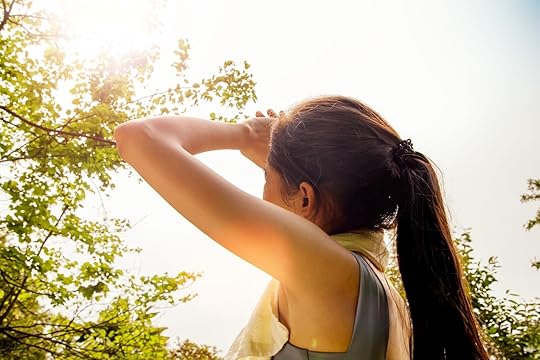
Everyone wants good weather for their vacation: sunshine, cloudless skies, and warmth. But there is such a thing as too much sun and warmth. Throughout the world, climate change is turning summers into scorchers and the heat is often becoming unbearable, making vacationers just as miserable as heavy rain would.
Luxury glamping resort Collective Retreat Hill County, located in Wimberley, Texas, knows that when summer rolls around in this part of country, it gets very, very hot. Sometimes even too hot for their guests to have a good time and enjoy all the outdoors activities available to them. That’s why they partnered with Sensible Weather, an insurance company that sells policies against inclement or extreme weather, including heat.
Guests at Collective Retreat Hill County can opt to purchase Sensible Weather Guarantee policy before they check in to protect their hard-earned vacation from being ruined by extreme heat. If the temperatures get very high and break the threshold predetermined by Sensible Weather during the guests’ stay, they’ll be notified by text that a refund is underway. According to Sensible Weather, guests don’t need to go through the rigmarole of filing a claim, or even cancel their stay or activities, to be refunded.
Before purchasing a Sensible Weather Guarantee policy for your next vacation, whether for rain or heat, make sure to look at what the conditions are. How hot does it need to be for you to get a refund? Or how many days of rain do you need to endure before you can get your money back? If you know you can’t bear anything above 100 degrees, there’s no need to sign up for a policy that will only refund you if the thermometer hits 105.
Protecting your vacation against poor weather is becoming more normal. Some hotels even offer rain refund. The Intercontinental Singapore, a five-star hotel in the city state of Singapore where it rains very frequently, now offers its guests a “Rain Resist Bliss” package. The package allows guests to be reimbursed one night of their stay if any of their planned activities are canceled due to wet weather. 
Lily of the Valley Hotel Offers Posh Amenities on the French Riviera
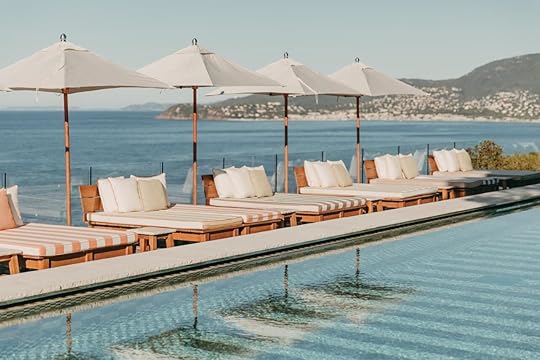
Melding the rugged Provençal countryside and the eternally desirable Côte d’Azur, the Lily of the Valley captures the best of the south of France. Every amenity and fitting exudes luxury that justifies the rates yet this five-star wellness retreat is loyal to those rustic charms often lost at the ritziest French Riviera resorts.
La Croix-Valmer claims the southern end of the Saint-Tropez peninsula with the hotel being less than a half-hour from the famous marina. Getting there from Nice Airport is a 90-minute journey by road although helicopter transfers are available for those in a hurry. Lily of the Valley isn’t quite beachfront but the elevated views and two huge shared pools make up for that. Besides, the untamed Gigaro Beach is less than a mile from the property. The French architect Philippe Starck looked to the Hanging Gardens of Babylon when designing this nature-inspired health and spa resort.
@jessie_khooHotel is lily of the valley in the south of France, private pool villa #southoffrance #hotelroomtour #lilyofthevalley #saintttropez #privatepoolvilla ♬ Aesthetic – Tollan Kim
We hope you love the Lily of the Valley Hotel! Just so you know, Matador may collect a small commission from the links on this page if you decide to book a stay. Listed prices are accurate as of the time of publication.
365 days of wellnessThis Mediterranean sanctuary is a temple of wellness with a concept more ambitious than your usual vacation massage, scrub, and facial combo. Lily of the Valley’s “Wellness Village” is divided into Weight Loss, Detox, Sport, and Better Aging.
Sport packages at the Shape Club start at €2,500 ($2,700) for the four-day Discover to €8,000 ($8,650) for a fortnight-long Reborn. These include evaluations and consultations, a personalized eating plan, daily coaching sessions, and a blend of fitness regimes targeting cardio and muscle development. Looping back to the resort’s ethos, all sports programs include regular pampering sessions at the spa.
There’s none of that “anti-aging” nonsense at this down-to-earth countryside retreat. Better Aging embraces the natural process by focusing on longevity and maximizing mobility while taking turns around the sun. Practitioners utilize Kinvent physio technology to create a tailored regime for each guest. Programs start at €3,200 ($3,470) for four days.
Best of all – Lily of the Valley Hotel keeps its doors open in all four seasons and the Shape Club is entirely optional. And, with over 300 days of sun a year, the Côte d’Azur is hard to top as a winter sun destination.
Chambres, suites, and villas on the Côte d’Azur Photo: Booking
Photo: Booking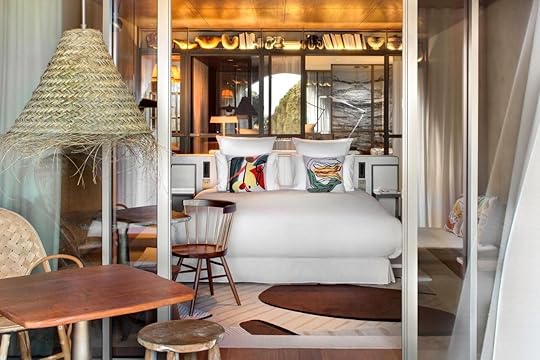 Photo: Booking
Photo: Booking Photo: Booking
Photo: Booking Photo: Booking
Photo: BookingSee more photos
Toot suite, this wellness luxury hotel keeps things intimate with only 38 rooms and six suites which means no dallying around. Two exclusive villas and two deluxe suites come with a private pool. Villa W grants spine-tingling 180° panoramas of the twinkling bay from the infinity pool that edges the entire length of the terrace. This three-bedroom villa accommodates six guests and has a dedicated butler, room service around the clock, and a private sauna.
The two-story Pool Suite Villa sits in a fragrant Mediterranean garden. All three bedrooms overlook the vegetation and sun-dappled pool with the master suite benefiting from a private terrace. Pool suites shrink from 210 square meters to a reasonable 95 and 86 but these petit domains still tout exclusive landscaped gardens and swim spaces.
Standard suites and guest rooms overlook the pine-studded hills, the celebrated Blue Coast, or the Shape Club facilities. Linens are sourced from the French company Garnier Thiebaut while the pillow menu ensures sweet dreams every night. The design fuses spa-like marble bathrooms with wall-to-wall windows and rough-sawn timber accents. The funky scatter cushions are the work of Ara Starck – daughter of the chief designer.
Experience the French Riviera lifestyle
@chaaalouuuu One of the dreamiest hotel :Lily of the Valley, La Croix-Valmer. #traveltiktok #hotelhideaway #sttropez #lilyofthevalleyhotel #hotel ♬ Take My Breath Away – EZI
 Photo: Booking
Photo: Booking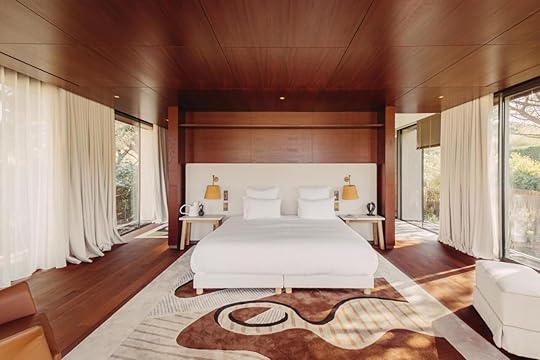 Photo: Booking
Photo: Booking Photo: Booking
Photo: Booking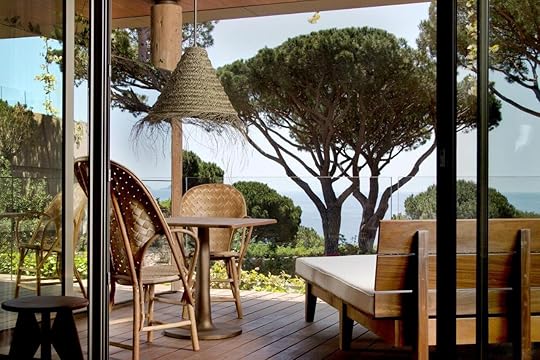 Photo: Booking
Photo: BookingSee more photos
All residences are a short stroll from Plage de Gigaro where the hotel maintains a private beach. The Beach Club at Lily of the Valley shuns the superyachts for paddle boards, transparent canoes, and windsurf boards. It’s a fun, family-friendly atmosphere with jovial staff on hand to offer tips. Don’t miss the Sunrise Paddle which concludes with a boho petit-déjeuner spread at Pépé.
The resort welcomes children who are encouraged to splash around the pools and join in with all watersports. However, the hotel is certainly tipped toward adult guests and doesn’t have much in the way of entertainment for youngsters.
Seasonal Provençal cuisine and fine French winesVincent Maillard stands at the helm of Lily of the Valley’s culinary portfolio. Aptly named signature restaurant Vista serves a diverse breakfast of buttery (or gluten-free) pastries, smoked salmon platters, gourmet granola, and perfectly flipped crêpes. Boissons come laced with collagen and other extras. There are plenty of options for those with no intention of cleansing: beef burgers with mountains of French fries, cheese boards, and Parisian-style éclairs bulging with cream sit alongside lighter options. Everything on the menu is seasonal and locally sourced.
Riviera living is all about balance and this health and wellness resort has a hefty wine list. The wine cellar is stocked with vintage French Champagnes, hearty Italian reds, and Alsace Reising. Naturally, there is a robust selection of Provençal rosé wines to accompany slow-cooked sea bass filet and lobster-stuffed vol-au-vent. Oenophiles are in their element at Lily of the Valley whereas fairweather drinkers can turn to the friendly sommeliers for a steer. There’s absolutely nothing pretentious about this upscale but humble boutique hotel with its earthy setting, laid-back vibe, and warm hospitality. 
Spain Banned Tourists From Taking Popular TikTok Video of the Country’s Most Famous Building

The Spanish government, like many authorities around the world, is taking a hard stance on TikTok content creators. The Sagrada Familia TikTok trend involved tourists visiting the famous landmark in Barcelona and capturing a video on the escalators leading out of the metro station. Tourists would film themselves on the moving stairs, which officials have deemed dangerous.
The unsafe viral fad featured people posing or dancing on the escalators, with the architectural marvel in the background. The annoying number of tourists attempting to film themselves on the escalators caused congestion and safety hazards. There were reports from local press of people falling and blocking the exit.
@thisgirlygracie I was so sad #spain #lasagradafamilia ♬ Live Your Life – T.I.
In this video, which has garnered 91,000 views, TikToker Gracie shared that there was a person (presumably a guard) “telling you off” for making videos. This didn’t seem to stop Gracie from doing it herself, but hopefully, the others will respect the rules in place. As seen in this TikTok, posters and signage are clear and unmissable.
@gabriellechristensen I guess tiktok put an end to this trend#barcelona #sagradafamilia #fyp ♬ baddie background – Dersim

As the Sagrada Familia is perhaps Spain’s most famous landmark, it sees over 3,000,000 visitors a year, and causing conjunction in or around the attraction is not only dangerous, it’s also an annoyance to other visitors and locals who use that metro stop during the daily commute.
The Sagrada Familia is nearing its long-awaited completion. Recent announcements by the Sagrada Familia Foundation suggest a finishing date of 2026. Construction of the Roman Catholic church began in 1882 and was spearheaded by the renowned architect Antoni Gaudí. Gaudí dedicated his life to the project but only saw a quarter of it finished before his passing in 1926. It’s hoped the 2026 target will be met as it coincides with the centenary of Gaudí’s death.
The Sagrada Familia TikTok trend is not the only craze to be banned at famous landmarks. Tourists have gotten the boot from many others due to safety concerns, property damage, or just plain annoyance. For example, Nepalese tourist spots, such as the birthplace of Buddha and the Gadhimai Temple, and other sacred sites have banned TikTokers. No doubt, we’ll hear of other authorities taking action throughout the summer holiday season. 
April 9, 2024
In Secluded Nayarit, Mexico, the W Punta de Mita Is a Luxury Oasis

As the sun began to set on our final day in Punta Mita, Mexico, we sat together in a circle on the sand, partaking in a cacao ceremony. With beans in hand, we repeatedly made silent affirmations to ourselves, holding the beans close to whatever needed the most healing. Raising the beans to our lips, we ate them to let them work their medicinal powers on us.
“Don’t be afraid to use your voice,” the Huichol medicine woman leading the ceremony told me as she went around the circle, revealing our individual Maya totems. Like with the Zodiac, each of us has a symbol that represents our birthdays and characteristics.
Mine is Etznab, or obsidian. I need to be sharp like the obsidian stone, I learned, slicing away what doesn’t serve me, unafraid to say what needs saying. Little did the medicine woman know how much I needed to hear that or how gratifying it was to hear after a few days of reinvigorating my spirit at the W Punta de Mita.
A hotel paradise with brand new beachview suites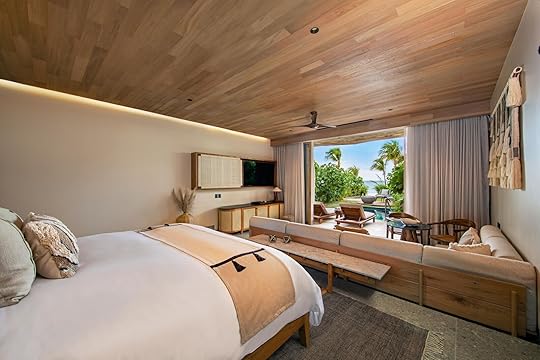
Photo: W Punta de Mita
Paraíso. Paradise. Few other words came to mind when I entered my Marvelous Suite at the W Punta de Mita to find a glass-enclosed, open-air soaking tub basking in the sun’s glow. Amid all the excitement, a labyrinth-esque pattern of stones in the bathroom floor served as a reminder to ground myself during my stay.
I was among the first guests to stay in these brand new suites at the W Punta de Mita, which glimpse the nearby beach. Decorated in neutral tones with a splash of greenery, the suites are a pleasant foil to the vibrant hues found elsewhere around the property. Spacious sunken living rooms allow guests to still see the views even from bed, uninhibited by the couch. It seems that the room’s design pays homage to the splendor awaiting guests outside.
All of the rooms at the W Punta de Mita are inspired by Mexican cultures. The Wonderful Escape rooms are bright and airy with splashes of color, and the spacious Oasis Suites offer the same. You trade in those colors for subtle cultural touch points until you get into the brand new suite categories of Wow, Extreme Wow, Marvelous, and Fabulous.

Photo: W Punta de Mita
Room rates vary depending on the season, available packages, and discounts, but they generally range from around $500 per night for a Wonderful Escape King room to just under $3,000 per night for an Extreme Wow two-bedroom suite.
If you decide to greet the day with a private breakfast in your room, as I did, you can take that one splash further if you stay in any of the new suites. The private plunge pools are the perfect spot for a luxurious floating breakfast. Indulge in some much-needed chilaquiles and fresh juice while wading in the water. Some curious birds like the Sinaloa crow may gingerly join your meal, crouching on a nearby wall or tree branch, waiting for you to drop a tantalizing treat.
When you’re ready to call it a night, a touch screen panel can draw your curtains (including the ones between the bed and the soaking tub area). Or ask the front desk if they can help light your private fire pit and make yourself some s’mores. There’s always something so comforting about a squishy, warmed marshmallow, even after a long day in the hot Punta Mita sun.
Swim, spa, and sweat at the W Punta de Mita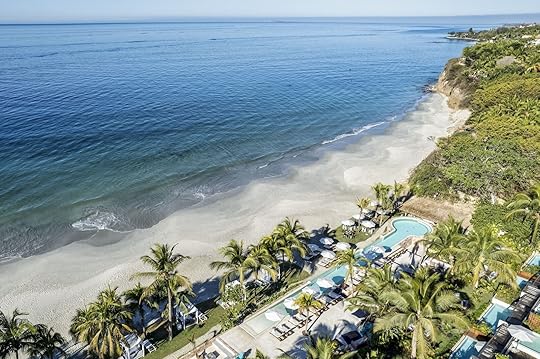
Photo: W Punta de Mita
Access to the water is a requisite for most people who visit Mexico’s coast. At the W Punta de Mita, there are two — well, technically three — options for your daily swim. You can help yourself to the resort’s private white-sand beach or float along in one of its two pools. The first pool, called WET, is located outside of the lobby building. WET Too, the adults-only pool, is right outside of the brand new suites. Both pools have cocktail and snack access, but the WET Deck area has one standout feature: a DJ.
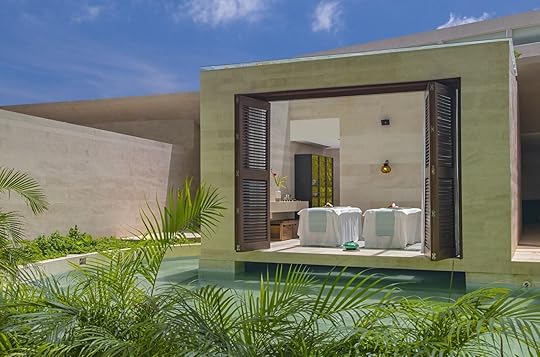
Photo: W Punta de Mita
On the calmer end of the amenity spectrum, there’s the AWAY Spa. Some will quip that it’s called that because it’s quite literally away from the rest of the resort. Indeed, tucked into a corner of the W Punta de Mita, the therapeutic haven lives among towering palms. Removed from the ambient sound and popular music flowing through the resort, you feel far away.
Even if you squeeze a spa appointment into a packed day, leave room for the hydrotherapy afterward. Sipping an herbaceous or fruity tea before gliding into one of the many therapy pools is the best way to end a relaxing session at AWAY. It could also be a nice way to follow up a workout at FIT, the resort’s on-site exercise space, which is located in the same part of the resort as the spa. There, the main attraction is the surrounding jungle, which you can practically see from any angle, thanks to floor-to-ceiling windows.
Restaurants at the W Punta de Mita, from formal to food truck
Photo: W Punta de Mita
Overlooking the lake, atop a slice of a tree that once sat on the property, Mesa 1 is an exclusive experience for resort guests. Accommodating up to 10 guests, the private seven-course meal may include dishes such as fresh sea bass, squid, and ceviche, topped off with something sweet such as fresh fruit hugging a housemade chocolate clamshell and macarons.
Since Mesa 1 only seats one group each night, it may not be possible to dine there during your trip. But fear not, you can experience a wide range of dishes elsewhere on property. Including the pool cocktail and snack bars, there are six dining spots at the W Punta de Mita.

Photo: W Punta de Mita
Spice Market serves Asian cuisine, with a particular focus on Malaysian, Thai, and Vietnamese flavors. At the smart-casual Spice Market, try the chicken samosas and Korean BBQ chicken — two flavors you might not expect to sample in the Riviera Nayarit that could top your tasting list for the trip. Be sure to ask your server about the recommended cocktail of the day. Like the food, the cocktails often have a thematic twist on a usual favorite.
Meanwhile two casual dining spots, Venazú and Chevycheria, showcase regional (or regional-adjacent) dishes. Constructed off of a vintage Chevy truck, the Chevycheria serves up the area’s specialty of ceviche and is open for lunch and dinner. Venazú is open for breakfast, lunch, and dinner. If you stop by Venazú for breakfast, get the blue corn waffles — the not-too-sweet waffles are like cornbread with a slight crunch. Accompany them with maple and coffee syrup if you prefer. Either way, they’re heaven — I ate them twice during my stay.
The day trip you don’t want to miss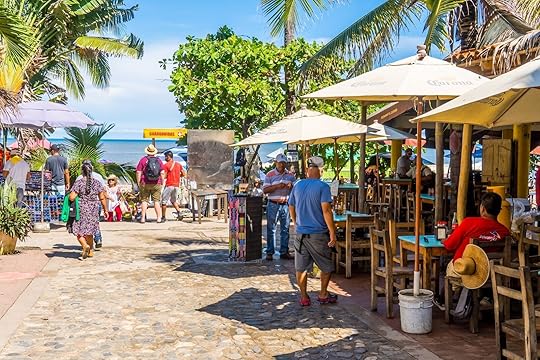
Photo: JackKPhoto/Shutterstock
The W Punta de Mita is fairly secluded. You can’t really step off the property for a bout of shopping or other excursions on foot, but you can reach the beautiful beach town of Sayulita by way of a 30-minute drive. With a vibrancy that mirrors the aesthetic at the W Punta de Mita, Sayulita centers on a town square that’s full of vendors selling earrings, hats, and the cutest shaped straw purses. As you peruse the stalls, remember that you can bargain gently with sellers, only about half of whom accept credit cards or digital payment methods, so come prepared with some cash. (There are also a few ATMs scattered around town.) When you’re ready for a break, grab a margarita at Don Pedro’s Restaurant and Bar. Steps away from the beach, you can watch the goings on while savoring a flavored or classic marg.
Getting to the W Punta de Mita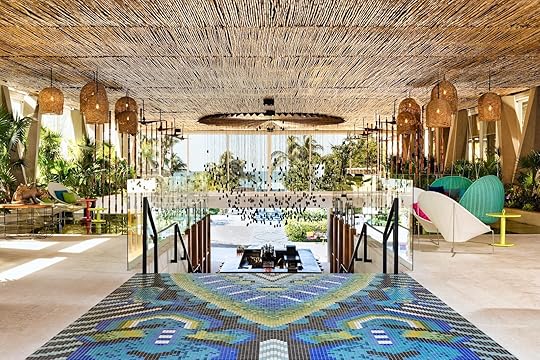
Photo: W Punta de Mita
Journeying from the Licenciado Gustavo Díaz Ordaz International Airport (Puerto Vallarta Airport) to the W Punta de Mita takes about 45 minutes. You can arrange a shuttle through the hotel or book through another local transportation company. Be aware that the drivers and timeshare folks soliciting at the airport are pushy. Just look for the company that you booked and keep going through to the exit of the airport — your driver will likely be waiting outside or right by the exit doors with a sign. 
Mount Everest Is Finally Addressing Its Enormous Poop Problem

Mount Everest is the tallest mountain on Earth and sits on the border of Nepal and Tibet, an independent region of China. While you can climb it from either side, most climbers make the approach from the Nepalese side. And unfortunately, that’s created a large problem for the Chinese government and Nepalese government and volunteers: cleaning up the massive amounts of waste on Mount Everest left behind by the mountain’s significant annual number of climbers.
Approximately 800 people attempt to summit Mount Everest each year, stopping at four camps along the way to acclimate. Climbers anywhere from 25 to 35 days on the mountain, and since the first commercial climbing operation began in 1992, there have been a few decades of the mountain welcoming a steady stream of climbers. That’s created a host of safety and environmental concerns, ranging from crowds on the former “Hillary Step” to piles of plastic left behind to one unavoidable issue: human excrement on Mount Everest.

Waste on Mount Everest generated at the various base camps is a significant problem. Photo: Daniel Prudek/Shutterstock
But this year, the `government of Nepal is taking steps to address the issue of human waste on Mount Everest, which estimates suggest could be around 26,000 pounds annually. Starting in 2024’s climbing season, which begins mid-April, everyone on the mountain will be required to carry, use, and carry out designated poop bags. (China attempted a similar policy in 2019). The Sagarmatha Pollution Control Committee in charge of the project told the BBC that it estimates about 8,000 bags will be used in the coming climbing season, each of which can be used several times. The bags are primarily for use on the higher sections of the mountains, as guiding companies at the lower base camps usually erect their own tented toilettes for clients.
Human waste on Mount Everest causes a host of problems, aside from the unpleasantness of climbing next to a steady trail of frozen poop. It creates significant odors, especially in areas that aren’t permanently covered in snow or are prone to freeze-and-thaw cycles. It can also compromise the water supply relied on by locals and villages in the remote, developing towns around the base.
The initiative is part of a greater multi-year push from governments and non-profits alike to encourage climbers to be more conscious of their ecological footprints while on Everest. The Mountain Cleanup Campaign, a non-profit partnership between the Nepalese Army and major western brands like London-based brand Unilever and Coca-Cola, has collected approximately 110 tons of trash from the mountain since 2019.
View this post on Instagram
A post shared by Gesman Tamang (@gesmantamang)
The next clean up will being mid-April 2024, with nearly two dozen volunteers lined up to remove both trash, as well as five bodies of climbers who died en route. More than 200 bodies are believed to remain on the mountain, according to the experts at Climbing Kilimanjaro. Bodies are left behind when they’re in areas where retrieval is too difficult, or die in conditions where sending in rescuers or retrieval teams would be unsafe. That’s the rational behind a second change for this climbing season reported by CNN: climbers will be required to wear GPS tracking devices to make it easier for rescuers in case of emergencies. 
This Five-Star Hilltop-Jungle Retreat Proves Laos as a Luxury Destination Worth Traveling For
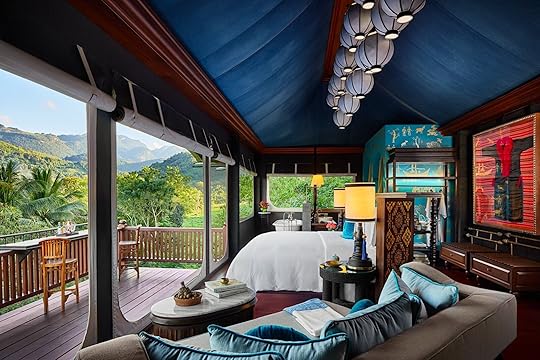
The “Golden Triangle” of Southeast Asia was named such due to the region’s thriving opium trade from the ’50s until the early 21st century. The mountainous region, where the borders of Thailand, Laos, and Myanmar meet, subsequently became fashionable with backpackers hopping between the countries before going south to Cambodia and Vietnam.
I’ve done this route a handful of times in my late teens and early twenties. Back then, I could have been the poster child for Lonely Planet’s South East Asia on a Shoestring guidebook. I had a $5-a-day budget, slept on overnight buses to avoid accommodation costs, ate street food, and appreciated the odd hot shower. Visiting the region as a backpacker had a profound impact on my life. Still, I wish I had the means to have a more elevated experience — especially in Laos, a country that’s seen a boom in the luxury market over the past couple of decades.
We hope you love the spaces and stays we recommend! Just so you know, Matador may collect a small commission from the links on this page if you decide to book a stay. Listed prices are accurate as of the time of publication.

Hilltop tents at Rosewood Luang Pradbang. Photo: Rosewood Hotels
Cities such as Luang Prabang have attracted five-star hoteliers who have established some of the best luxury hotels in the country, seamlessly blending world-class service, fine dining, and opulent accommodations with the stunning natural backdrop of the region’s mountainous landscapes and lush rice paddies.

Laos follows Theravada Buddhism, the strictest form of Buddhism. Monks adhere to a set of rules called the Vinaya, which emphasizes simplicity and detachment from worldly possessions. Photo: M2020/Shutterstock
Laos, landlocked by Myanmar and China to the northwest, Vietnam to the east, and Cambodia and Thailand to the south, might not have the Southeast Asian white beaches so many travelers flock to, but spirituality, culture, fertile plains along the Mekong River, and the people make up for it. Occupied by the French until 1953, the streets of Luang Prabang and the capital, Vientiane, are lined with colonial architecture, and you’ll note a distinctive French influence on the food scene here, too.
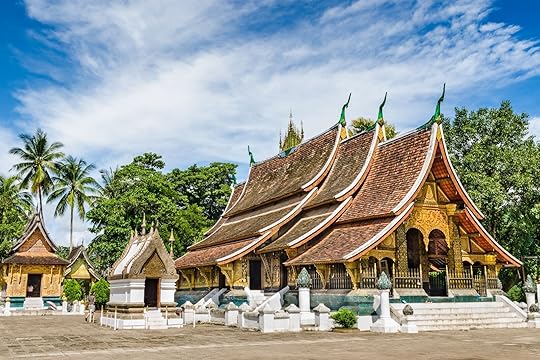 One of the highlights of Luang Prabang, Wat Xieng Thong was built between 1559-1560 under King Setthathirath. Photo: Wuttichok Panichiwarapun/Shutterstock
One of the highlights of Luang Prabang, Wat Xieng Thong was built between 1559-1560 under King Setthathirath. Photo: Wuttichok Panichiwarapun/Shutterstock Photo: Guitar photographer/Shutterstock
Photo: Guitar photographer/ShutterstockLuang Prabang is one of the best examples of a blend of traditional Lao culture and modern luxury. Located in northern Laos, on the meeting point of the Mekong and Nam Khan rivers, the town was declared a UNESCO World Heritage Site in 1995 and is home to some of the most sophisticated Buddhist temples in Southeast Asia.
Today, there are a handful of five-star hotels and resorts, from colonial-style mansions with upscale fine dining experiences to private retreats with infinity pools and stunning views of the surrounding mountains and rivers. One of the better hotels is the jungle hideaway Rosewood Luang Prabang.
The Rosewood lies on a jungle-clad hilltop on the outskirts of town. You’ll note a familiar French colonial architecture interwoven with influences from ancient Laotian temples, but unlike other five-star hotels in Luang Prabang, the riverside and hilltop dwellings are surrounded by a lush forested valley. Here, you’ll find yourself away from the hustle and bustle of Luang Prabang’s town center, yet still close enough to enjoy. The complimentary on-demand transfers between the Rosewood and town ensure easy access to historical sites like Wat Mai and Wat Chomsi, or the lively night markets.
 Photo: Rosewood Hotels
Photo: Rosewood Hotels Photo: Rosewood Hotels
Photo: Rosewood Hotels Photo: Rosewood Hotels
Photo: Rosewood Hotels Photo: Rosewood HotelsSee more photos
Photo: Rosewood HotelsSee more photosDesigned by the visionary architect, Bill Bensley, the Rosewood has 23 rooms. You can choose from elegant rooms and suites, waterfall pool villas, or opt for a stay in one of the hilltop tents — Rosewood’s first (and very successful) foray into glamping. Each abode offers stunning views of the waterfalls, rivers, and hillsides — blurring the lines between indoor and outdoor living. Bensley is also known for incorporating sustainable practices into his designs, and the hotel was built under strict UNESCO guidelines to preserve the surrounding World Heritage Site.
From private candle-lit dinners by the waterfall, complimentary bikes to cycle into town, guided hikes, cooking classes, and traditional bamboo rod fishing to Laotian therapies at the Sense Spa — in true Rosewood fashion, the amenities and packaged experiences are beautifully aligned with the local culture and landscape.
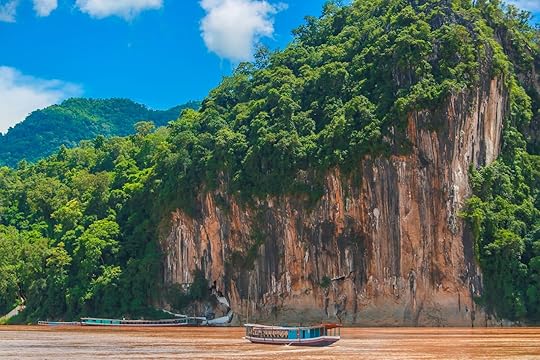
Sailing down the Mekong River allows you to take in the stunning scenery, remote villages, and historical sites that are inaccessible on foot. Photo: Eve Sittawat/Shutterstock
You can also book a sunset river cruise. For centuries, the Nam Khan and Mekong waterways were the only way people could get in or out of Luang Prabang, and today, it remains the lifeblood of the region. Rosewood’s sailing will take you past the town on a luxury wooden boat embellished with local handwoven textiles.

The turquoise pools at the base of Kuang Si Waterfall are ideal for swimming, although there is a small section designated as sacred and swimming is not allowed. Photo: Preto Perola/Shutterstock
Another must is the trek to Kuang Si Waterfall. Yes, it’s on most lists, but for good reason. The hotel runs guided tours into the mountains in the comfort of the hotel vehicle. It takes around three to five hours in total, and the hike is achievable by most with a good level of fitness. The route winds through forested hills, farmland, limestone grottos, and small villages before reaching Kuang Si, where you can cool off in the turquoise waters before retreating back to the five-star comfort of your hillside hideaway. 
This Mountainsmith Toiletry Bag Survived Six Years of Global Travel
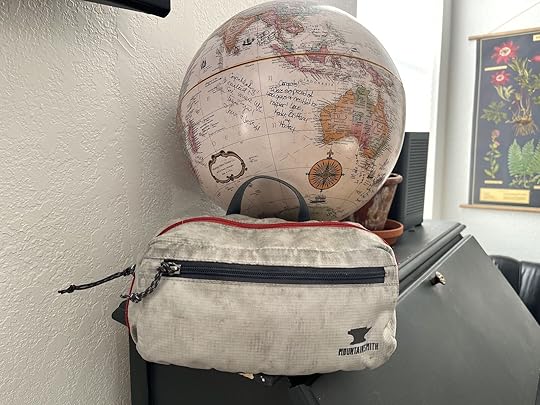
For the past six years, I’ve used the Mountainsmith Essentials Stash Small Travel Organizer Duffel Bag as my travel toiletry bag. It’s the best toiletry bag for frequent adventure travelers, and has been all over the world with me – from the high alpine of Kyrgyzstan’s Tien Shan Mountains to the heart of Medellin’s Poblado neighborhood – on trips both professional and recreational. At this point, its condition is not pristine. One could frankly describe it as quite repulsive, in fact, and lately, I’ve hidden it from my wife when we travel together because she would waste no time in describing it as such.
But here’s the thing. No matter how much time we spend on the road together, my Mountainsmith toiletry bag and I maintain an understanding. It holds all my knick-nacks – important stuff like a toothbrush and razor alongside personal preferences like a TSA-approved Leatherman and the small bottle of “facial mist” I borrowed from the cabin the one time I flew business class on a story assignment. In return, I promise to continue taking it on the road with me rather than swapping it out for the next new gimmicky toiletry bag that comes along.
So far the deal has worked out for us both. This toiletry bag is now the longest-serving piece of travel gear I own. I know it inside and out. I often pack it last in my carry-on because I know exactly how to squeeze it in there without having to sacrifice anything else to make room. I don’t love this toiletry bag in the way that I love Blink-182 or Triscuits, but I am quite fond of it. I often tell fellow travelers that they should get one. Besides it’s low cost ($24.95), here’s why.
We hope you love the Mountainsmith toiletry bag! Just so you know, Matador may collect a small commission from the links on this page if you decide to make a purchase. Listed prices are accurate as of the time of publication.
What I like about the Mountainsmith Essentials Stash Small Travel Organizer Duffel Bag The Mountainsmith toiletry bag after six years traversing the globe. Photo: Tim Wenger
The Mountainsmith toiletry bag after six years traversing the globe. Photo: Tim Wenger This is what the Mountainsmith toiletry bag looks like new. See next photo for mine. Photo: Amazon
This is what the Mountainsmith toiletry bag looks like new. See next photo for mine. Photo: AmazonA toiletry bag should be the Khloé Kardashian of your travel setup. That is to say, it must make you feel extra organized even when you aren’t. The last thing you want is to arrive late to a hotel room, strung out from a long day of travel, only to have to sift through a bunch of junk to find your toothbrush. This Mountainsmith toiletry bag has a special holder for toothbrushes and other thin, long-necked accessories that is visible right when the bag is opened.
Two zipped elastic webbing containers hold stuff like Q-tips, pill bottles, deodorant, and my Leatherman. The bag is modern enough that it has storage areas for cables and an electric razor while being simple enough that it zips seamlessly every time, no matter how full it is. Once unzipped, each section of the bag is see-through so there’s no forgetting where anything is.
The bag is largely water-resistant. This is great since it generally lives adjacent to a sink when in use. I’ve never had any issues with its contents getting soaked, or with moisture impacting the zippers. The exterior of my bag has a bit of discoloration, as you can see in the photos, but that’s merely the result of extensive use rather than any fault on the bag’s part.
What I would change about the Mountainsmith Essentials Stash Small Travel Organizer Duffel Bag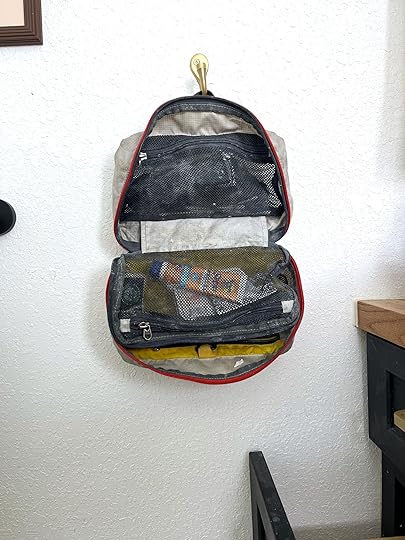
The Mountainsmith toiletry bag hangs well. Photo: Tim Wenger
I’d change two small things about this toiletry bag if given the opportunity. First, while it does have a hook to hang in restrooms, it doesn’t unfold the way that some toiletry bags do. This doesn’t impact me too much because it does unfurl to the point where you can easily grab what’s in there, but the view when unfurled isn’t significantly better than the tabletop view.
The other thing I would change has less to do with the Mountainsmith toiletry bag and more to do with myself. I would change how covered in toothpaste and facial shavings I allow it to get so that it shines more like new. Looking at any prized piece of travel gear should inspire nostalgia for past moments of road-born glory, while simultaneously kindling one’s motivation for future adventures. It’s hard to grab hold of that fire when it’s covered in grime.
Alas, I used this opportunity to clean the toiletry bag. It now looks like this:
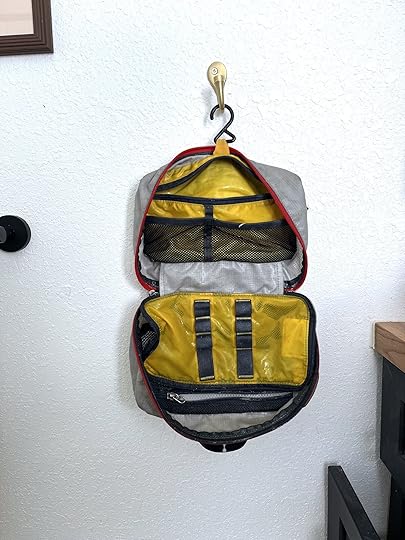
So fresh. Photo: Tim Wenger
Mountainsmith toiletry bag specsThe Mountainsmith toiletry bag is on-par with similar small toiletry bags as far as sizing. What separates it is the sheer amount of stuff it can hold in such a compact size. Here are its specs:
Dimensions: 4.5″ x 7.25″ x 2″ (11.5 x 18.5 x 5 cm)Weight: 5 oz (0.13 kg)Color: Glacier GreyCompartments: Dual compartment organizer with zippered internal divider, elastic webbing storage for toothbrush, scissors, clippers, etc.Coated mesh backpanel pocket for see-through storageMultiple organizer pockets for toiletries, cables, accessories, etc.Three internal zippered pocketsWebbing haul handleSingle vanity hook for hanging More like thisTravelI Travel for a Living, and This Company's Shirts and Pants Go Everywhere I Do
More like thisTravelI Travel for a Living, and This Company's Shirts and Pants Go Everywhere I Do
Matador Network's Blog
- Matador Network's profile
- 6 followers



